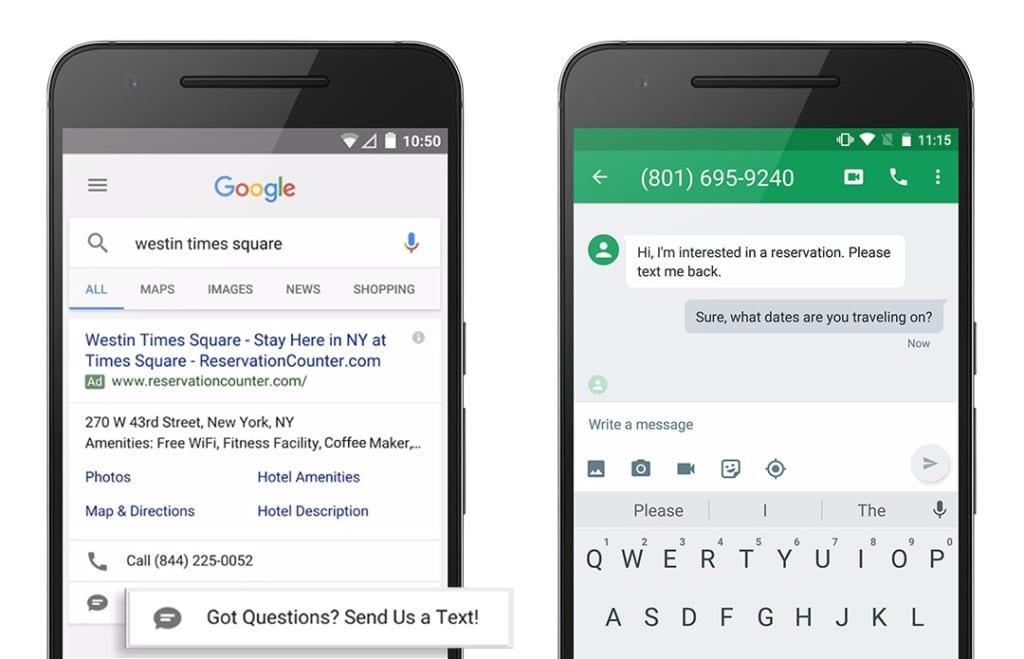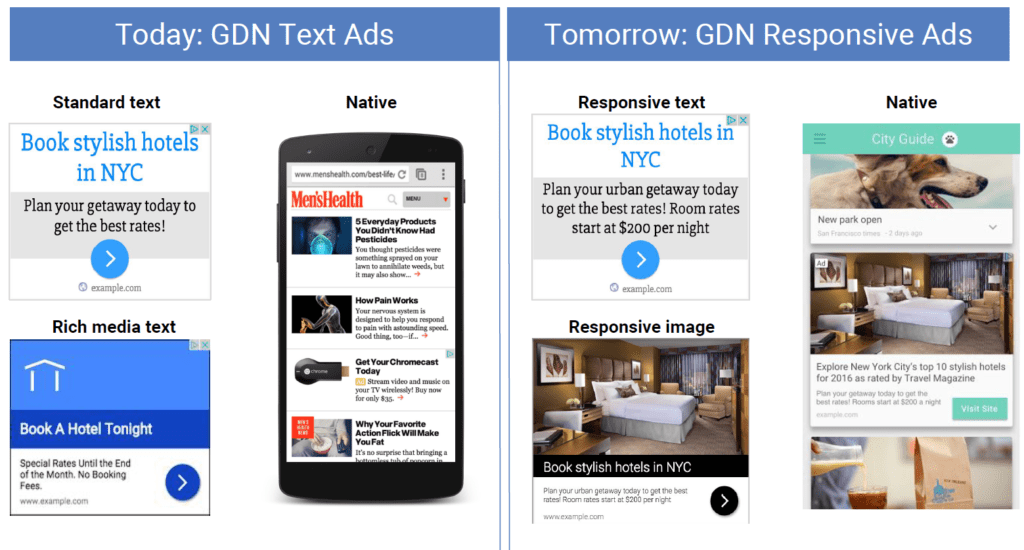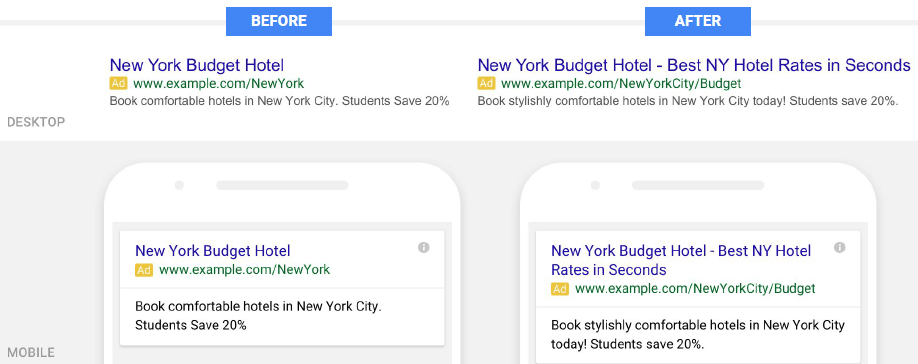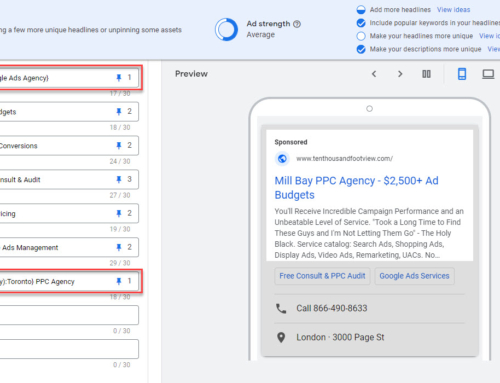It was a huge year for AdWords with many changes, particularly in the 3rd quarter where we saw text ads completely revamped. Implementing new AdWords features is tremendously important for keeping ahead of your competitors. Here are what I feel were the most important AdWords updates of 2016.
#10 – Price Extensions
This one just made our cut for the top-10 because the feature is not yet widely available. Price extensions display pricing info below your ads for different products & services you offer. Conceptually the extension is fantastic. Including prices in ads has always served to (a) drive higher CTRs for advertisers that compete on price, and (b) eliminate clicks from visitors looking for free or low-cost options you don’t offer. The problem is, the extension only runs on mobile devices and only when your ad appears in top position. This greatly limits the usefulness of the extension. Google is testing the extension on desktop ads, stay tuned.
#9 – Multiple User Account Login
While it hasn’t improved AdWords performance, this feature sure makes life a lot easier for users with multiple logins. Late in 2016 Google added the ability to add multiple logins in both AdWords and Analytics. This means no more logging out and logging back in under another user account. You can now open multiple browser tabs, each with a different user login. Each user account you add is accessible below the main account for easy access. Finally!
#8 – Message Extensions

Message extensions provide a clickable link to send an SMS (text message) directly from mobile ads. You can configure a predefined message which makes it super easy for the prospect to reach out. That prefabricated message will indicate to the recipient that the message has originated from Google AdWords. In a world where people are averse to being put on hold, texting is a great way to get in touch with potential customers. We’ve seen a nice increase in ‘direct from ad’ conversions after setting up this feature for some of our clients. Ideally, you should implement this on a dedicated text number, so that you can assign the responsibility of responding to different staff members. Alternatively, you can create multiple text extensions that go to different mobile numbers on a schedule.
#7 – Conversion Tracking Updates
Google made a number of improvements to conversion tracking in 2016. First, they’ve done away with the oft-confused ‘converted clicks’ metrics. In its place, we can now select whether to count all conversions or one conversion automatically. At the same time, Google added the ability to choose whether or not to track cross-device conversions. In a multi-device world, this helps tremendously, especially with e-commerce campaigns. Lastly, Google added conversion attribution models. While most users have stuck with the default ‘last-click’ attribution, the ability is there to attribute conversions using different models such as first-click, linear, and others. Google has also added a new attribution console to simplify attribution analysis.
#6 – Responsive Display Ads

Goodbye image ads, hello responsive display ads. Instead of building display ads using cookie cutter designs from AdWords or outsourcing creative, responsive ads are beautiful and can be created in a snap. Responsive ads adapt to the size and style of the hosting website or app, ensuring your ads look like they belong there. Far from ‘native’ but much better than ‘banners,’ these ads look great and usually drive higher CTRs.
#5 – Campaign Drafts & Experiments
Back in February, Google revamped and integrated campaign drafts and experiments. The new tools allow you to develop a number of campaign changes in ‘draft’ and then turn them on when you’re ready. This is a great feature if you have a campaign change approval process, or if you work collaboratively on campaign updates. In addition, ‘experiments’ were updated to allow you to run multiple experiments at once and to see how the experiment compares to baseline performance.
#4 – Measurement of In-Store Conversions
Up until the introduction of this feature, if you had a physical store, it was difficult to measure the success of your AdWords campaigns. Not so anymore. Google introduced In-Store Conversions this past year. In a nutshell, people who click on your mobile ad and then visit the store are now tracked as conversions. Google does this by tracking mobile phone location activity. Initially only available for large retailers, the feature is now starting to roll out to smaller stores. Whether you sell coffee, nails, or cars, this is a must have feature for brick & mortars.
#3 – Demographic Targeting for Search
This great new AdWords feature allows us to set bid adjustments for, or exclude, different genders and age groups in search ads. My recommendation is not to go too crazy with this out of the gate. Keep in mind that paid search is an on-demand ad platform. Don’t be so quick to dismiss certain demographics without testing first. If a 55-year old man is searching for cosmetics he probably wants to buy cosmetics. Collect some data first, then implement prudent adjustments based on statistically significant trends. Implemented correctly, you can drive huge performance improvements in many market niches.
#2 – Device Level Bidding
Back in 2013, Google greatly reduced our ability to set specific device bids. Fortunately, device level bidding has returned. Bid adjustments can now be set at both the campaign and ad group level for 3 device types; computers, tablets, and mobile devices (smartphones). We’ve already seen huge performance improvements by including tablet bid adjustments, and by migrating adjustments to the ad group level where appropriate.
#1 – Expanded Text Ads

Google created Expanded Text Ads (ETAs) to drive more revenue (for Google) through paid search. By eliminating RSA (right side ads) and bulking up text ads Google generated higher average CTRs across search ads globally. To keep pace, we’ve all updated to the new format that allows about 50% more copy for our message. The only loser here is organic search. If CTRs are up across the board, that means organic CTRs are down across the board. If you haven’t implemented ETAs yet, you’re falling behind, get on with it already!
What’s Next?
One big surprise is the lack of the new GUI demonstrated by Google back in May. The GUI is still in Beta and those that have used it generally like it – after the initial ‘where the heck is…’ wears off. With an improved workflow many AdWords pros are looking forward to getting their hands on this. I wouldn’t be surprised if this launches globally this quarter.
AdWords is constantly evolving. Advertisers that don’t adopt are quickly left behind. If you’d like to stay up with the latest AdWords features, please check out my Best Resources for Google AdWords News & Info post from a few months ago.
Would you like help with your Google AdWords account? Learn about our Google AdWords management services.





